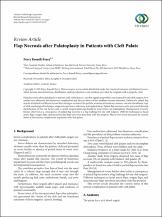Flap necrosis after palatoplasty in patients with cleft palate

View/
Trabajo
(application/pdf: 4.288Mb)
(application/pdf: 4.288Mb)
Date
2015-07-26Author(s)
Rossell-Perry, Percy
Metadata
Show full item recordAbstract
Palatal necrosis after palatoplasty in patients with cleft palate is a rare but significant problem encountered by any cleft surgeon. Few studies have addressed this disastrous complication and the prevalence of this problem remains unknown. Failure of a palatal flap may be attributed to different factors like kinking or section of the pedicle, anatomical variations, tension, vascular thrombosis, type of cleft, used surgical technique, surgeon's experience, infection, and malnutrition. Palatal flap necrosis can be prevented through identification of the risk factors and a careful surgical planning should be done before any palatoplasty. Management of severe fistulas observed as a consequence of palatal flap necrosis is a big challenge for any cleft surgeon. Different techniques as facial artery flaps, tongue flaps, and microvascular flaps have been described with this purpose. This review article discusses the current status of this serious complication in patients with cleft palate.
Collections
- Artículos [274]
Subject
Publisher
Hindawi Publishing Corporation
Rights
info:eu-repo/semantics/openAccess







